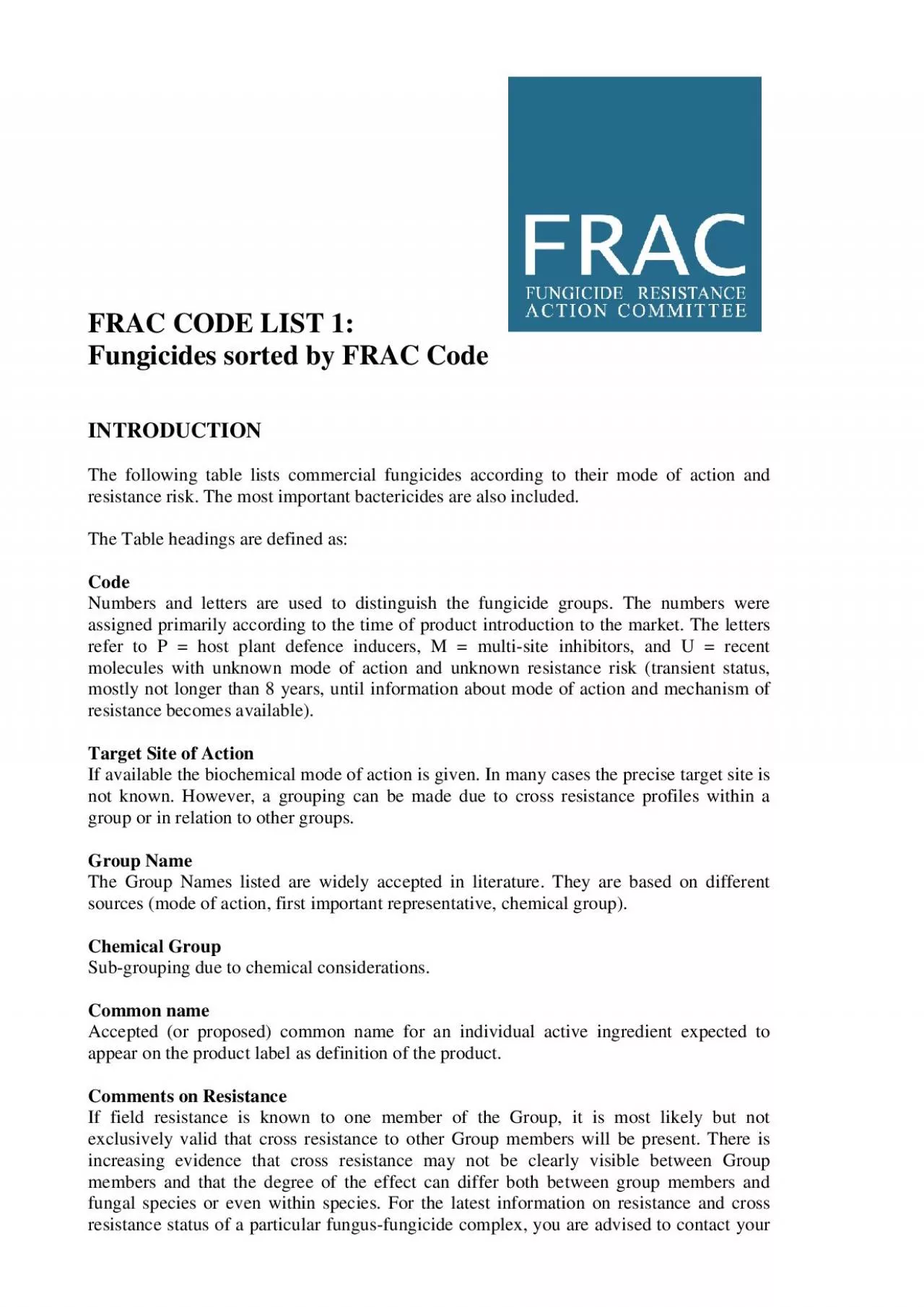

Fungicides sorted by FRAC Code s according to their mode of action and resistance risk The most important bactericides are also included Numbers and letters are used to distinguish the fungic ID: 955689
Download Pdf The PPT/PDF document "FRAC CODE LIST 1" is the property of its rightful owner. Permission is granted to download and print the materials on this web site for personal, non-commercial use only, and to display it on your personal computer provided you do not modify the materials and that you retain all copyright notices contained in the materials. By downloading content from our website, you accept the terms of this agreement.
FRAC CODE LIST 1: Fungicides sorted by FRAC Code s according to their mode of action and resistance risk. The most important bactericides are also included. Numbers and letters are used to distinguish the fungicide groups. The numbers were assigned primarily according to the time of product introduction to the market. The letters refer to P = host plant defence inducers, M = multi-site inhibitors, and U = recent molecules with unknown mode of action and unknown resistance risk (transient status, mostly not longer than 8 years, until information about mode of action and mechanism of resistance beco
mes available). If available the biochemical mode of action is given. In many cases the precise target site is not known. However, a grouping can be made due to cross resistance profiles within a The Group Names listed are widely accepted in literature. They are based on different sources (mode of action, first important representative, chemical group). Sub-grouping due to chemical considerations. Accepted (or proposed) common name for an individual active ingredient expected to Comments on ResistanceIf field resistance is known to one member of the Group, it is most likely but not exclusively valid that cross resistance to o
ther Group members will be present. There is increasing evidence that cross resistance may not be clearly visible between Group members and that the degree of the effect can differ both between group members and fungal species or even within species. For the latest information resistance status of a particular fungus-fungicide complex, you are advised to contact your TARGET SITE OF ACTION GROUP NAME CHEMICAL GROUP COMMON NAME COMMENTS benzimidazoles Resistance common in many fungal species. Several target site mutations, mostly E198A/G/K, F200Y Positive cross resistance between the group members. Negative cross resist
ance to N-Phenylcarbamates High risk. See FRAC Benzimidazole Guidelines for resistance management. 2 NADH c y tochrome c reductase in lipid dicarboximides vinclozolin Resistance common in Botrytis cinerea and found in some other fungal species. Several mutations found in OS1 histidine Cross resistance common between the group members. Medium to high risk. See FRAC Dicarboximide Guidelines for resistance management. imidazoles piperazines triforine pyridines pyrifenox pyrimidines diniconazole epoxiconazole fluquinconazole flusilazole imibenconazole prothioconazole simeconazole There are great differences in the activ
ity spectra of the different DMI fungicides. Resistance is known in various fungal species. Several resistance mechanisms known incl. target site mutation Y136F, Generally wise to accept that cross active against the same fungus. DMI fungicides are Sterol Biosynthesis resistance to other SBI classes. Medium risk. See FRAC SBI Guidelines for resistance management TARGET SITE OF ACTION GROUP NAME CHEMICAL GROUP COMMON NAME COMMENTS methoxyacrylates azoxystrobin pyraclostrobin oximino acetates trifloxystrobin dimoxystrobin oxazolidine-diones dihydro-dioxazines fluoxastrobin -fungicides utside imidazolinones fena
midone Resistance known in various fungal species. Target site mutations G143A, F129L and additional mechanisms. Cross resistance shown between all High risk. See FRAC QoI Guidelines for resistance management. kinase in osmotic nal transduction yrroles) Resistance found sporadically, mechanism speculative (OS-2 kinase). management required. G-proteins in earl y quinolines quinoxyfen Resistance known. Medium risk. Resistance management required. romatic lipid peroxidation heteroaromatics 1,2,4-thiadiazoles Resistance known to some fungi. Low to medium risk. Cross resistance patterns complex due to different activit
y isobenzofuranone pyrroloquinolinone pyroquilon iosynthesis tricyclazole carboxamide diclocymet iosynthesis Resistance known. Medium risk. Resistance management required. demethylation in sterol biosynthesis hydroxyanilides fenhexamid management required. thiocarbamates pyributicarb Herbicide and fungicide. Resistance not epoxidase in sterol (SBI: class IV) allylamines medical fungicide chitin synthase polyoxins l p y rimidine Resistance known. Medium risk. Resistance management required. TARGET SITE OF ACTION GROUP NAME CHEMICAL GROUP COMMON NAME COMMENTS unknown benzotriazines triazoxide Resistance
not known flusulfamide Resistance not known diclomezine Resistance not known silthiofam Resistance reported. Risk low pyrimidinamides diflumetorim Resistamce not known cinnamic acid biosynthesis and cell wall deposition management required. 41 protein synthesis attachment of aminoacyl-tRNA to ribosomal acceptor (A) site oxytetracycline Bactericide. Resistance known. High risk. Resistance management required. unknown thiocarbamate methasulfocarb Resistance not known salicylic acid P2 benzisothiazole ( antifungal activity) P host plant defence induction P3 thiadiazole-Resistance not know